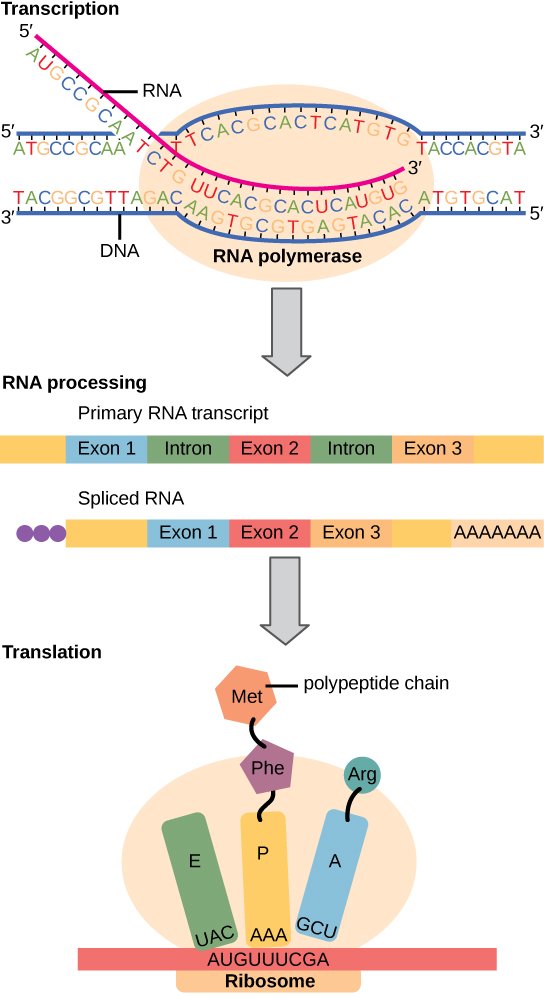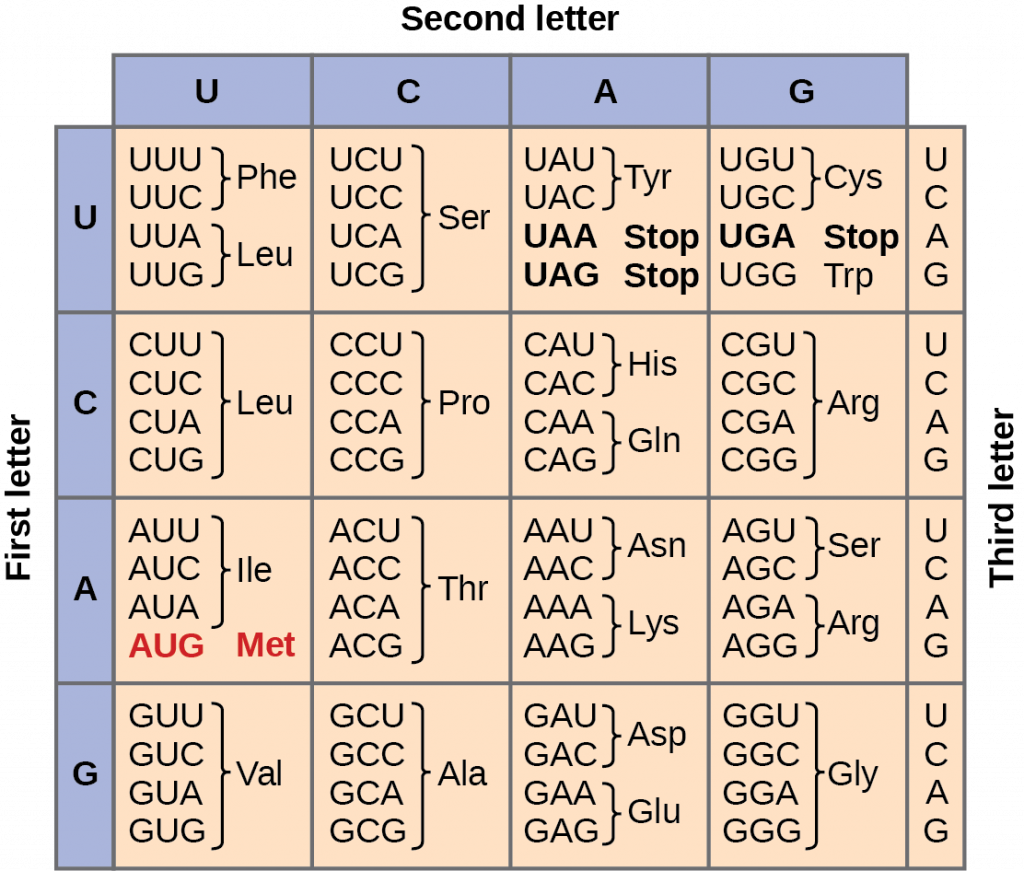1.5: Molecular Genetics
- Page ID
- 141893
\( \newcommand{\vecs}[1]{\overset { \scriptstyle \rightharpoonup} {\mathbf{#1}} } \)
\( \newcommand{\vecd}[1]{\overset{-\!-\!\rightharpoonup}{\vphantom{a}\smash {#1}}} \)
\( \newcommand{\dsum}{\displaystyle\sum\limits} \)
\( \newcommand{\dint}{\displaystyle\int\limits} \)
\( \newcommand{\dlim}{\displaystyle\lim\limits} \)
\( \newcommand{\id}{\mathrm{id}}\) \( \newcommand{\Span}{\mathrm{span}}\)
( \newcommand{\kernel}{\mathrm{null}\,}\) \( \newcommand{\range}{\mathrm{range}\,}\)
\( \newcommand{\RealPart}{\mathrm{Re}}\) \( \newcommand{\ImaginaryPart}{\mathrm{Im}}\)
\( \newcommand{\Argument}{\mathrm{Arg}}\) \( \newcommand{\norm}[1]{\| #1 \|}\)
\( \newcommand{\inner}[2]{\langle #1, #2 \rangle}\)
\( \newcommand{\Span}{\mathrm{span}}\)
\( \newcommand{\id}{\mathrm{id}}\)
\( \newcommand{\Span}{\mathrm{span}}\)
\( \newcommand{\kernel}{\mathrm{null}\,}\)
\( \newcommand{\range}{\mathrm{range}\,}\)
\( \newcommand{\RealPart}{\mathrm{Re}}\)
\( \newcommand{\ImaginaryPart}{\mathrm{Im}}\)
\( \newcommand{\Argument}{\mathrm{Arg}}\)
\( \newcommand{\norm}[1]{\| #1 \|}\)
\( \newcommand{\inner}[2]{\langle #1, #2 \rangle}\)
\( \newcommand{\Span}{\mathrm{span}}\) \( \newcommand{\AA}{\unicode[.8,0]{x212B}}\)
\( \newcommand{\vectorA}[1]{\vec{#1}} % arrow\)
\( \newcommand{\vectorAt}[1]{\vec{\text{#1}}} % arrow\)
\( \newcommand{\vectorB}[1]{\overset { \scriptstyle \rightharpoonup} {\mathbf{#1}} } \)
\( \newcommand{\vectorC}[1]{\textbf{#1}} \)
\( \newcommand{\vectorD}[1]{\overrightarrow{#1}} \)
\( \newcommand{\vectorDt}[1]{\overrightarrow{\text{#1}}} \)
\( \newcommand{\vectE}[1]{\overset{-\!-\!\rightharpoonup}{\vphantom{a}\smash{\mathbf {#1}}}} \)
\( \newcommand{\vecs}[1]{\overset { \scriptstyle \rightharpoonup} {\mathbf{#1}} } \)
\( \newcommand{\vecd}[1]{\overset{-\!-\!\rightharpoonup}{\vphantom{a}\smash {#1}}} \)
\(\newcommand{\avec}{\mathbf a}\) \(\newcommand{\bvec}{\mathbf b}\) \(\newcommand{\cvec}{\mathbf c}\) \(\newcommand{\dvec}{\mathbf d}\) \(\newcommand{\dtil}{\widetilde{\mathbf d}}\) \(\newcommand{\evec}{\mathbf e}\) \(\newcommand{\fvec}{\mathbf f}\) \(\newcommand{\nvec}{\mathbf n}\) \(\newcommand{\pvec}{\mathbf p}\) \(\newcommand{\qvec}{\mathbf q}\) \(\newcommand{\svec}{\mathbf s}\) \(\newcommand{\tvec}{\mathbf t}\) \(\newcommand{\uvec}{\mathbf u}\) \(\newcommand{\vvec}{\mathbf v}\) \(\newcommand{\wvec}{\mathbf w}\) \(\newcommand{\xvec}{\mathbf x}\) \(\newcommand{\yvec}{\mathbf y}\) \(\newcommand{\zvec}{\mathbf z}\) \(\newcommand{\rvec}{\mathbf r}\) \(\newcommand{\mvec}{\mathbf m}\) \(\newcommand{\zerovec}{\mathbf 0}\) \(\newcommand{\onevec}{\mathbf 1}\) \(\newcommand{\real}{\mathbb R}\) \(\newcommand{\twovec}[2]{\left[\begin{array}{r}#1 \\ #2 \end{array}\right]}\) \(\newcommand{\ctwovec}[2]{\left[\begin{array}{c}#1 \\ #2 \end{array}\right]}\) \(\newcommand{\threevec}[3]{\left[\begin{array}{r}#1 \\ #2 \\ #3 \end{array}\right]}\) \(\newcommand{\cthreevec}[3]{\left[\begin{array}{c}#1 \\ #2 \\ #3 \end{array}\right]}\) \(\newcommand{\fourvec}[4]{\left[\begin{array}{r}#1 \\ #2 \\ #3 \\ #4 \end{array}\right]}\) \(\newcommand{\cfourvec}[4]{\left[\begin{array}{c}#1 \\ #2 \\ #3 \\ #4 \end{array}\right]}\) \(\newcommand{\fivevec}[5]{\left[\begin{array}{r}#1 \\ #2 \\ #3 \\ #4 \\ #5 \\ \end{array}\right]}\) \(\newcommand{\cfivevec}[5]{\left[\begin{array}{c}#1 \\ #2 \\ #3 \\ #4 \\ #5 \\ \end{array}\right]}\) \(\newcommand{\mattwo}[4]{\left[\begin{array}{rr}#1 \amp #2 \\ #3 \amp #4 \\ \end{array}\right]}\) \(\newcommand{\laspan}[1]{\text{Span}\{#1\}}\) \(\newcommand{\bcal}{\cal B}\) \(\newcommand{\ccal}{\cal C}\) \(\newcommand{\scal}{\cal S}\) \(\newcommand{\wcal}{\cal W}\) \(\newcommand{\ecal}{\cal E}\) \(\newcommand{\coords}[2]{\left\{#1\right\}_{#2}}\) \(\newcommand{\gray}[1]{\color{gray}{#1}}\) \(\newcommand{\lgray}[1]{\color{lightgray}{#1}}\) \(\newcommand{\rank}{\operatorname{rank}}\) \(\newcommand{\row}{\text{Row}}\) \(\newcommand{\col}{\text{Col}}\) \(\renewcommand{\row}{\text{Row}}\) \(\newcommand{\nul}{\text{Nul}}\) \(\newcommand{\var}{\text{Var}}\) \(\newcommand{\corr}{\text{corr}}\) \(\newcommand{\len}[1]{\left|#1\right|}\) \(\newcommand{\bbar}{\overline{\bvec}}\) \(\newcommand{\bhat}{\widehat{\bvec}}\) \(\newcommand{\bperp}{\bvec^\perp}\) \(\newcommand{\xhat}{\widehat{\xvec}}\) \(\newcommand{\vhat}{\widehat{\vvec}}\) \(\newcommand{\uhat}{\widehat{\uvec}}\) \(\newcommand{\what}{\widehat{\wvec}}\) \(\newcommand{\Sighat}{\widehat{\Sigma}}\) \(\newcommand{\lt}{<}\) \(\newcommand{\gt}{>}\) \(\newcommand{\amp}{&}\) \(\definecolor{fillinmathshade}{gray}{0.9}\)Genes and Proteins
Since the rediscovery of Mendel’s work in 1900, the definition of the gene has progressed from an abstract unit of heredity to a tangible molecular entity capable of replication, transcription, translation, and mutation. Genes are composed of DNA and are linearly arranged on chromosomes. Some genes encode structural and regulatory RNAs. There is increasing evidence from research that profiles the transcriptome of cells (the complete set all RNA transcripts present in a cell) that these may be the largest classes of RNAs produced by eukaryotic cells, far outnumbering the protein-encoding messenger RNAs (mRNAs), but the 20,000 protein-encoding genes typically found in animal cells, and the 30,o00 protein-encoding genes typically found in plant cells, nonetheless have huge impacts on cellular functioning.
Protein-encoding genes specify the sequences of amino acids, which are the building blocks of proteins. In turn, proteins are responsible for orchestrating nearly every function of the cell. Both protein-encoding genes and the proteins that are their gene products are absolutely essential to life as we know it.

Replication, Transcription, and Translation are the three main processes used by all cells to maintain their genetic information and to convert the genetic information encoded in DNA into gene products, which are either RNAs or proteins, depending on the gene. In eukaryotic cells, or those cells that have a nucleus, replication and transcription take place within the nucleus while translation takes place outside of the nucleus in cytoplasm. In prokaryotic cells, or those cells that do not have a nucleus, all three processes occur in the cytoplasm.
Replication is the basis for biological inheritance. It copies a cell’s DNA. The enzyme DNA polymerase copies a single parental double-stranded DNA molecule into two daughter double-stranded DNA molecules. Transcription makes RNA from DNA. The enzyme RNA polymerase creates an RNA molecule that is complementary to a gene-encoding stretch of DNA. Translation makes protein from mRNA. The ribosome generates a polypeptide chain of amino acids using mRNA as a template. The polypeptide chain folds up to become a protein.
- Recall the central dogma of biology
The Central Dogma: DNA Encodes RNA, RNA Encodes Protein
The central dogma of molecular biology describes the flow of genetic information in cells from DNA to messenger RNA (mRNA) to protein. It states that genes specify the sequence of mRNA molecules, which in turn specify the sequence of proteins. Because the information stored in DNA is so central to cellular function, the cell keeps the DNA protected and copies it in the form of RNA. An enzyme adds one nucleotide to the mRNA strand for every nucleotide it reads in the DNA strand. The translation of this information to a protein is more complex because three mRNA nucleotides correspond to one amino acid in the polypeptide sequence.

Transcription: DNA to RNA
Transcription is the process of creating a complementary RNA copy of a sequence of DNA. Both RNA and DNA are nucleic acids, which use base pairs of nucleotides as a complementary language that enzymes can convert back and forth from DNA to RNA. During transcription, a DNA sequence is read by RNA polymerase, which produces a complementary, antiparallel RNA strand. Unlike DNA replication, transcription results in an RNA complement that substitutes the RNA uracil (U) in all instances where the DNA thymine (T) would have occurred. Transcription is the first step in gene expression. The stretch of DNA transcribed into an RNA molecule is called a transcript. Some transcripts are used as structural or regulatory RNAs, and others encode one or more proteins. If the transcribed gene encodes a protein, the result of transcription is messenger RNA (mRNA), which will then be used to create that protein in the process of translation.
Translation: RNA to Protein
Translation is the process by which mRNA is decoded and translated to produce a polypeptide sequence, otherwise known as a protein. This method of synthesizing proteins is directed by the mRNA and accomplished with the help of a ribosome, a large complex of ribosomal RNAs (rRNAs) and proteins. In translation, a cell decodes the mRNA’s genetic message and assembles the brand-new polypeptide chain. Transfer RNA, or tRNA, translates the sequence of codons on the mRNA strand. The main function of tRNA is to transfer a free amino acid from the cytoplasm to a ribosome, where it is attached to the growing polypeptide chain. tRNAs continue to add amino acids to the growing end of the polypeptide chain until they reach a stop codon on the mRNA. The ribosome then releases the completed protein into the cell.
DNA to protein: This interactive shows the process of DNA code being translated to a protein from start to finish!
The Genetic Code Is Degenerate and Universal
The genetic code is degenerate as there are 64 possible nucleotide triplets (43), which is far more than the number of amino acids. These nucleotide triplets are called codons; they instruct the addition of a specific amino acid to a polypeptide chain. Sixty-one of the codons encode twenty different amino acids. Most of these amino acids can be encoded by more than one codon. Three of the 64 codons terminate protein synthesis and release the polypeptide from the translation machinery. These triplets are called stop codons. The stop codon UGA is sometimes used to encode a 21st amino acid called selenocysteine (Sec), but only if the mRNA additionally contains a specific sequence of nucleotides called a selenocysteine insertion sequence (SECIS). The stop codon UAG is sometimes used by a few species of microorganisms to encode a 22nd amino acid called pyrrolysine (Pyl). The codon AUG, also has a special function. In addition to specifying the amino acid methionine, it also serves as the start codon to initiate translation. The reading frame for translation is set by the AUG start codon.
The genetic code is universal. With a few exceptions, virtually all species use the same genetic code for protein synthesis. The universal nature of the genetic code is powerful evidence that all of life on Earth shares a common origin.

Key Points
- The genetic code is universal because it is the same among all organisms.
- Replication is the process of copying a molecule of DNA.
- Transcription is the process of converting a specific sequence of DNA into RNA.
- Translation is the process where a ribosome decodes mRNA into a protein.
- The genetic code is degenerate because 64 codons encode only 22 amino acids.
Key Terms
- codon: a sequence of three adjacent nucleotides, which encode for a specific amino acid during protein synthesis or translation
- ribosome: protein/mRNA complexes found in all cells that are involved in the production of proteins by translating messenger RNA
- degenerate: the redundancy of the genetic code (more than one codon codes for each amino acid)
Contributions and Attributions
- OpenStax College, Biology. October 16, 2013. Provided by: OpenStax CNX. Located at: http://cnx.org/content/m44518/latest...ol11448/latest. License: CC BY: Attribution
- Principles of Biochemistry/Cell Metabolism I: DNA replication. Provided by: Wikibooks. Located at: en.wikibooks.org/wiki/Princip...NA_replication. License: CC BY-SA: Attribution-ShareAlike
- Cell Biology/Genes/Gene translation. Provided by: Wikibooks. Located at: en.wikibooks.org/wiki/Cell_Bi...ne_translation. License: CC BY-SA: Attribution-ShareAlike
- translation. Provided by: Wiktionary. Located at: en.wiktionary.org/wiki/translation. License: CC BY-SA: Attribution-ShareAlike
- gene. Provided by: Wiktionary. Located at: en.wiktionary.org/wiki/gene%23English. License: CC BY-SA: Attribution-ShareAlike
- transcription. Provided by: Wiktionary. Located at: en.wiktionary.org/wiki/transcription. License: CC BY-SA: Attribution-ShareAlike
- protein. Provided by: Wiktionary. Located at: en.wiktionary.org/wiki/protein. License: CC BY-SA: Attribution-ShareAlike
- OpenStax College, How Genes Are Regulated. October 30, 2013. Provided by: OpenStax CNX. Located at: http://cnx.org/content/m45480/latest/. License: CC BY: Attribution
- Structural Biochemistry/Nucleic Acid/Translation. Provided by: Wikibooks. Located at: en.wikibooks.org/wiki/Structu...id/Translation. License: CC BY-SA: Attribution-ShareAlike
- Principles of Biochemistry/Cell Metabolism II: RNA transcription. Provided by: Wikibooks. Located at: en.wikibooks.org/wiki/Princip..._transcription. License: CC BY-SA: Attribution-ShareAlike
- protein. Provided by: Wiktionary. Located at: en.wiktionary.org/wiki/protein. License: CC BY-SA: Attribution-ShareAlike
- messenger RNA. Provided by: Wikipedia. Located at: en.Wikipedia.org/wiki/messenger%20RNA. License: CC BY-SA: Attribution-ShareAlike
- DNA. Provided by: Wiktionary. Located at: en.wiktionary.org/wiki/DNA. License: CC BY-SA: Attribution-ShareAlike
- OpenStax College, Introduction. October 16, 2013. Provided by: OpenStax CNX. Located at: http://cnx.org/content/m44518/latest...e_15_00_01.jpg. License: CC BY: Attribution
- Principles of Biochemistry/Cell Metabolism II: RNA transcription. Provided by: Wikibooks. Located at: en.wikibooks.org/wiki/Princip..._transcription. License: CC BY-SA: Attribution-ShareAlike
- OpenStax College, Biology. October 16, 2013. Provided by: OpenStax CNX. Located at: http://cnx.org/content/m44522/latest...ol11448/latest. License: CC BY: Attribution
- Principles of Biochemistry/Cell Metabolism I: DNA replication. Provided by: Wikibooks. Located at: en.wikibooks.org/wiki/Princip...NA_replication. License: CC BY-SA: Attribution-ShareAlike
- Structural Biochemistry/Nucleic Acid/Translation. Provided by: Wikibooks. Located at: en.wikibooks.org/wiki/Structu...id/Translation. License: CC BY-SA: Attribution-ShareAlike
- codon. Provided by: Wiktionary. Located at: en.wiktionary.org/wiki/codon. License: CC BY-SA: Attribution-ShareAlike
- Boundless. Provided by: Boundless Learning. Located at: www.boundless.com//biology/de...ion/degenerate. License: CC BY-SA: Attribution-ShareAlike
- ribosome. Provided by: Wiktionary. Located at: en.wiktionary.org/wiki/ribosome. License: CC BY-SA: Attribution-ShareAlike
- OpenStax College, Introduction. October 16, 2013. Provided by: OpenStax CNX. Located at: http://cnx.org/content/m44518/latest...e_15_00_01.jpg. License: CC BY: Attribution
- OpenStax College, The Genetic Code. October 16, 2013. Provided by: OpenStax CNX. Located at: http://cnx.org/content/m44522/latest...e_15_01_02.jpg. License: CC BY: Attribution

